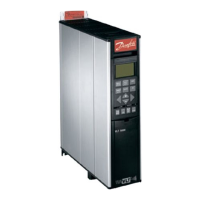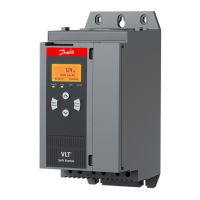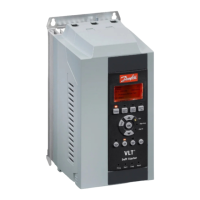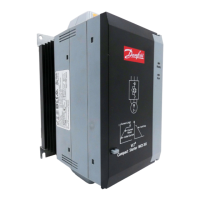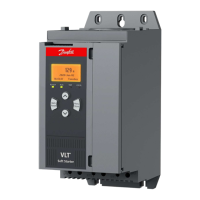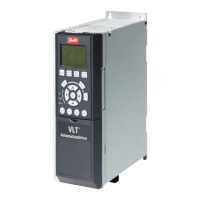Synchronizing controller
MG.10.N4.02 - VLT is a registered Danfoss trademark 63
Setting the parameters
For this we recommend to have the description of parameters at hand. See the VLT
5000/VLT5000Flux Operating Instructions.
NOTE: It is very important that the VLT is optimized for the motor before optimizing the
Synchronizing controller. First you record the motor data and perform an AMA (Automatic Motor
Adaptation) if possible and then you can start programming your synchronization functions
Parameter 205 Maximum reference: Set the frequency for a value that is about 10% higher
than the maximum value of parameter 716.
Example:
Motor 7.5kW, 1460
1
/
min
at 50Hz, speed of the application approx. 1800
1
/
min
1,1*
*
Nom
nApplicatioNom
N
Nf
=
50 1800
1460
11
1
1
Hz *
*,
min
min
= 62Hz maximum ref. value
Parameter 701 Record “1” to start the test program.
Parameter 709 When performing position synchronization this parameter is used to insert a
filter to compensate for an oscillating master signal. If, for example, the master
is experiencing shock loads the pid loop of the synchronizing controller will
have a tendency to oscillate as well. A negative value must be entered.
Example:
If a filter factor of –100000 (100 ms) is used the correction is balanced within:
1000/(filter factor *10)= 1 second.
Parameter 711 Record the slave encoder type. “0” represents an incremental encoder.
Parameter 712 Record the resolution of the slave encoder.
Parameter 713 Record the master encoder type. “0” represents an incremental encoder.
Parameter 714 Record the resolution of the master encoder.
Parameter 715 Direction of rotation: Record “1” for clockwise rotation of the slave. Record “-1”
if the slave is to run in the opposite direction.
Parameter 716 Record maximum RPM measured at the slave encoder.
Parameter 717 Minimum ramp: Set the time in ms for the slave drive to accelerate from
standstill to maximum speed (par. 716). Consider the value carefully as this
setting will highly affect the control accuracy!
Parameter 718 Ramp type: Record “0” for linear ramp and “1” for s-ramp. NOTE: S-ramp
requires higher acceleration torque.
Parameter 719 Maximum track error: Record the value that is to generate “Track error”
indication in the display, if exceeded.
Parameter 720 Reversing procedure: Record “0” if reversing is allowed, “1” if the slave must
always follow the direction of the master or “2” if reversing is not allowed.
